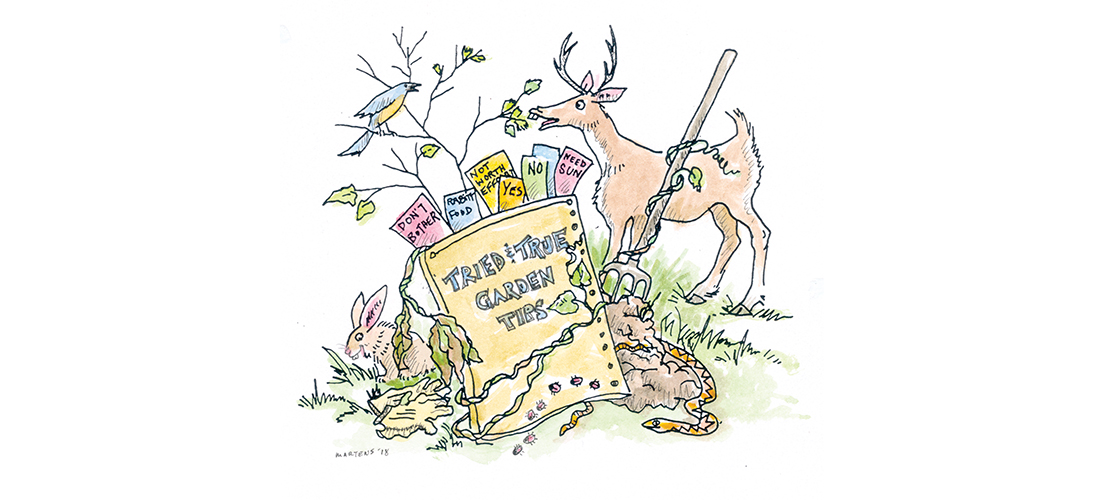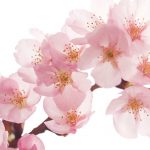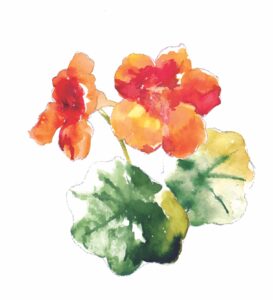
Tips from the tried and failed
By Susan S. Kelly
So it’s finally a warm weekend in spring, and you long to have something to pick, prune, pluck or even deadhead in your yard, garden, or the scorched-earth, weed-whacked plot that passes for it. But you’re too busy or lazy to learn Latin names, and it’s embarrassing to go to the garden center and say, “I want those, you know, pink flowers that are tall,” or “ . . . that tree that looks pretty in the spring.”
Herewith, therefore, your tried-and-true primer, from someone whose personal dirt’s worth is incalculable due to all the tried-and-failed specimens I purchased, trucked in, planted, tended, and either rejoiced or mourned over. Or, alternatively, ripped out, chopped down, and consigned to the mulch pile. Because, in my yard, like professors seeking tenure, you either produce or perish.
Magnolia — Best climbing tree ever. But as a flower, forget it. The blooms are never low enough to cut, and besides, they only last a day. Leave it alone and just sniff the blooms big as plates. Come fall, your children can play army with the seedpods.
Gardenia — Only reliable if you live east of Raleigh. As for picked longevity, ditto the one-day warning above. Touch the vanilla petals and your invisible skin oils will brown them not invisibly. Heavenly aroma, though I rejected them in my wedding bouquet because the overpowering sweetness tends to provoke a gag reflex. Still, nice in a teacup or that silver scallop shell your grandmother used as an ashtray.
Camellia — Cannot be picked or arranged satisfactorily. For viewing only. Bonus: unlike azaleas, stay glossy green all year.
Orange daylilies — My neighbor calls them “privy lilies,” presumably because folks once planted them to beautify the outhouse. But they beat the heck out of the stubby gold hybrids planted in interstate medians. Go for it.
Queen Anne’s lace — Field and roadside freebies, but bring them inside and they proceed to shed fine white dust all over everything.
Marigolds — Often dumped upon as plebeian blooms, but for this commoner, nothing smells as good as one of their stems, broken.
Cleome — Pink, pretty, proliferous, and self-seeding. What else could you ask for in an airy weed that loves neglect, red clay, and 1,000-degree days? In late summer, take the seeds to the office, to a friend, or, for that matter, to another place in the yard. Strew with abandon.
Black-eyed Susans — As the Chatham Blanket tagline once boasted, they cover a multitude of sins. Require little effort and even less skill to stuff in a glass, metal or pottery container. Do not disparage that which can withstand full sun when you can’t. You call them invasive, I call them indispensable.
Knockout roses — The Johnny-come-lately “it” flowering shrub. Utterly unpickable, but compensates for this shortcoming in sheer size and volume.
Peonies — The ultimate bloomer. Often disqualified for, as the farmers like to say, seasonality, but worth the wait, the space and the ants. Go ahead, gird your loins, and bring yourself to cut and enjoy them before a 20-minute thunderstorm causes irreparable loss and gnashing of teeth.
Hydrangeas — Bingo! Once upon a time, my mother referred to hydrangeas as “trash shrubs.” I love this. Or rather, I love reminding her of this now that no one can live without them.
Ivy — Just, no. You’ll be sorry. Plus, snakes like it. Use pachysandra instead.
There you have it. No more feeling humiliated by Biltmore with its perfect planters and borders and gardens featuring every floral texture and contrast and interest which nevertheless are superior to previously-envied Disney World’s planters and borders and gardens. Because Biltmore’s flowers actually grow, rather than simply get replaced by Snow White’s 426 dwarves every night.
Or, how not to waste your time or money on What Won’t Work Because We’re Not England. PS
Susan Kelly is a blithe spirit, author of several novels, and proud new grandmother.





